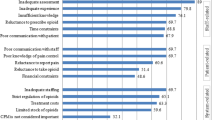Abstract
Cancer pain is still not treated adequately. The barriers impeding its appropriate treatment include lack of knowledge, erroneous beliefs and inappropriate attitudes with regard to pain, which are sustained by some or all of those involved in the problem. The present study shows the results of an exploratory survey using a large sample of specialists in clinical oncology. Its main objective is to evaluate daily analgesic practices and compliance with clinical guidelines in order to identify areas that should be improved in this particular therapeutic fi eld. Information collection from the responders was in the form of a self-administered written questionnaire, structured in three thematic areas: clinical patterns and resources used in pain treatment in clinical practice, pain and pain-relief therapy, and theoretical knowledge and decision-making in clinical practice. The study identifi ed those skills that most need improvement in the treatment of pain (scientifi c and technical knowledge and clinical decision-making capacity of professionals) in order to reduce the unjustifi ed variability in current clinical practice.
Similar content being viewed by others
References
Christo PJ, Mazloomdoost D (2008) Cancer pain and analgesia. Ann N Y Acad Sci 1138:278–298
Van den Beuken-van Everdingen M, de Rijke J, Kessels A et al (2007) Prevalence of pain in patients with cancer: a systematic review of the past 40 years. Ann Oncol 18:1437–1449
Pat RB (2003) Tratamiento del dolor producido por cáncer: Un componente esencial del tratamiento integral del Cáncer. In: Rubin P, Williams JP (eds) Oncologia Clinica, 8th Edn. Elsevier España, Madrid
Mantyh PW (2006) Cancer pain and its impact on diagnosis, survival and quality of life. Nat Rev Neurosci 10:797–809
World Health Organization (1996) Cancer pain relief, 2nd Edn. World Health Organization, Geneva
Sanz J (2002) Cuidados paliativos. In: Rodés J, Carné X, Trilla A (eds) Manual de terapéutica médica. Elsevier España, Madrid
Dy SM, Asch SM, Naeim A et al (2008) Evidence-based standards for cancer pain management. J Clin Oncol 26:3879–3885
Lorenz KA, Karl A, Lynn J et al (2008) Evidence for improving palliative care at the end of life: a systematic review. Ann Intern Med 148:147–159
Goldberg GR, Morrison RS (2007) Pain management in hospitalized cancer patients: a systematic review. J Clin Oncol 25:1792–1801
Gordon DB, Dahl JL, Miaskowski C et al (2005) American Pain Society recommendations for improving the quality of acute and cancer pain management. Arch Intern Med 165:1574–1580
Zernikow B, Hasan C, Hechler T et al (2008) Stop the pain! A nation-wide quality improvement programme in paediatric oncology pain control. Eur J Pain 12:819–833
Azevedo K, Kimura M, Jacobsen M (2006) The WHO analgesic ladder for cancer pain control, twenty years of use. How much pain relief does one get from using it? Support Care Cancer 14:1086–1093
Reid CM, Forbes K (2007) Pain in patients with cancer: still a long way to go. Pain 132:229–230
Janjan NA, Cleelan CS (2008) Pain and suffering during cancer therapy: continued sins of omission. Int J Radiat Oncol Biol Phys 72:6–8
Cleeland CS (1987) Barriers to the management of cancer pain. Oncology 12[Suppl]:89
Eaton KD, Frieze DA (2008) Cancer pain: perspectives of a medical oncologist. Curr Pain Headache Rep 12:270–276
Carulla J, Jara C, Sanz J et al (2007) Oncologists’ perceptions of cancer pain management in Spain: the real and the ideal. Eur J Pain 11:352–359
Davis MP, Walsh D, Lagman R, LeGrand SB (2005) Controversies in pharmacotherapy of pain management. Lancet Oncol 6:696–704
González Barón M, Ordoñez Gallego A (2003) Dolor y Cáncer: Hacia una Oncología sin dolor. Editorial Panamericana, Madrid
Goldberg GR, Morrison RS (2007) Pain management in hospitalized cancer patients: a systematic review. J Clin Oncol 25:1792–1801
Gómez P, Herrero A, Muñoz JM (2009) Estudio de utilización de analgésicos opiáceos en un hospital general universitario. Rev Soc Esp Dolor 16:373–380
Author information
Authors and Affiliations
Corresponding author
Rights and permissions
About this article
Cite this article
Escobar Álvarez, Y., Rodríguez Sánchez, C.A., Caballero Martínez, F. et al. Professional survey on knowledge and clinical patterns of pain management in Spanish medical oncology. Clin Transl Oncol 12, 819–824 (2010). https://doi.org/10.1007/s12094-010-0603-8
Received:
Accepted:
Published:
Issue Date:
DOI: https://doi.org/10.1007/s12094-010-0603-8




